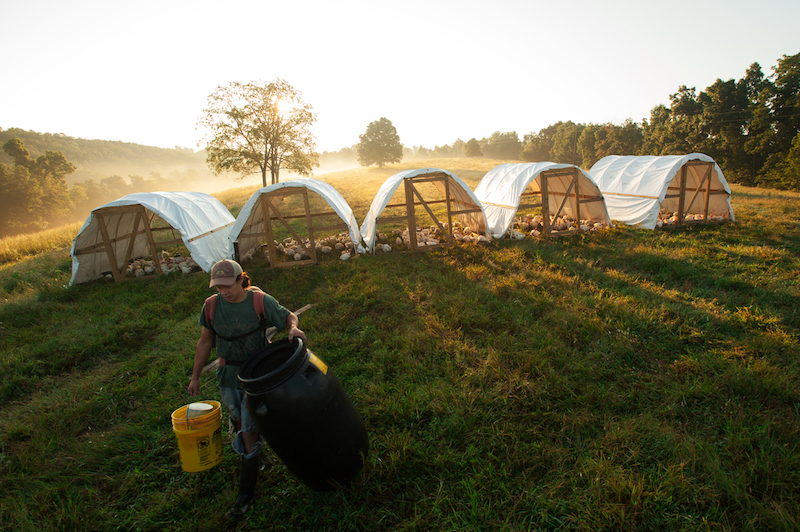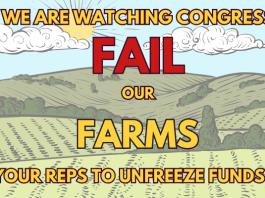Andrea Todt and Cody Hopkins first generation farmers who started out in Arkansas in 2006 with the hope of generating their own income as well as jobs for their community. They had some success in getting off the ground, selling to farmers’ markets and restaurants in central Arkansas. But after about 7 years, they hit what Cody calls “the ceiling.” The logistics of getting food onto customers’ plates were very complex: Processing was 3 hours away, distribution was a challenge, and the struggle to make it all work just wasn’t sustainable. They needed a different solution.

How About A Cooperative?
In the years that Cody and Andrea had been farming, they had developed relationships with fellow farmers, sharing loads of feed, loads of animals to processing, and deliveries to markets. They could see that working together offered opportunities for efficiency of scale.
The question was, how could the farmers work together without losing autonomy, and maintain control over the value chain, the quality of the product that they were producing and selling? Could they form some kind of cooperative together?
At the same time that Cody and Andrea and their farmer neighbors were chewing over this idea, Heifer International was revamping its US program. Heifer International is a global non-profit best known for providing start-up livestock to farmers in developing countries. But it has a strong US component as well with a new emphasis: working with groups of farmers to develop a market and a business model. By working with Cody, Andrea and their neighbors on building a cooperative in Arkansas, Heifer International hoped to develop a model that might work for other groups of farmers interested in trying the same thing.
With technical assistance from Heifer International, the Grassroots Farmers Cooperative was born. Their model: Letting farmers focus on farming while supporting them with a professional staff to connect the farmers to markets, and a processor to ensure product could get to those markets. Putting it all together took several years. Exploratory conversations began in 2013, and in April of 2014, the cooperative was formalized. Getting a processor to be part of the cooperative took all of 2015.
The First Customer
The first customer signed on soon after the cooperative agreement was signed. The customer wanted meat birds, raised to specific standards, and at a volume that no single farm could produce. This meant that all the farmers had to conform to a single set of standards, which they understood had to be part of the cooperative model. They were able to fill the customer’s order. Though that was the only thing the farmers sold through the cooperative that first year, Cody describes it as “a galvanizing step.”

Having that first customer showed them that farmers in the cooperative had to give up some autonomy. Everyone had to raise the same chicken breed, in the same set up. The farmers agreed on the poultry production practices. “There is room for folks to do some things differently, but we are focused on being consistent and being analytical – to determine the best practices possible. Every Tuesday, farmers submit feed use and average bird weight to track production, mortality rate, etc.”
Providing consistency to the customer is one of the challenges of working together. In this case the cooperative is working toward agreement on the kinds of animals they raise and supply to customers. One farm is providing the beef genetics for the cooperative, but the group has not yet agreed on which breed of pigs is best. As part of the decision making process, they share hog weights and look at how farms are doing relative to each other, and what they are doing differently.
The Working Details
The farmers work together to develop production standards, and decide which wholesale customers to take on. They also set the prices.
Setting pricing and the processing schedule at the beginning of the year let’s farmers know what price they will get and when they must provide livestock. After that, each can manage their operations in a way that suits them best. Adjustments to prices and processing schedules can be made during the year, but the farmers on the board all agree on the pricing at the outset, and then agree to any changes that must be made.
About two-thirds of the cooperative’s product is sold wholesale and to restaurants, with one-third going out in direct sales. For each sale, the farmers get about 75% of the purchase price. Of the remaining quarter, about 15% goes to processing, and about 10% goes to the Grass Roots Cooperative to cover the cost of administration.

There are currently 15 farms participating in the Grass Roots Cooperative. Most of them are first generation farms. Some are 5-10 years old, but some started with the founding of Grass Roots. For beginning farmer, it is a great experience to get off the ground with the support of the cooperative, using TA from their fellow farmers and from HI.
In 2015, Grass Roots took another big step. Farmers agreed to make the cooperative the single outlet for selling their livestock. Then the cooperative secured a capital source that individual farmers could draw from, as a line of credit to help farmers expand their livestock numbers. They pay off their line of credit as they bring in livestock for sale.
“It’s worked out extremely well,” says Cody. He credits Heifer International with a big role in their success. “They’re known for giving out animals to folks, but they do much more sophisticated work than that, to help farmers get to the next level. They look at U.S. farmers as a testing ground for these different organizational structures.”
The cooperative doesn’t replace the individual farm that wants to sell directly to the customer, but it provides an option for farmers having difficulty finding a market that market.
Could This Work For You?
According to Cody, this is a scale-able model, that can work for groups of different sizes, and to provides the farmers in the group with support that can be a lifeline. He believes farmers in different places can work together to develop a similar group structure. But so far, he says, “There isn’t a clear model or cookie cutter to do this. If we can develop a prototype that is successful, it can help folks to launch this, and do this themselves.” It takes time, effort, and cooperation, but it can help farmers be stronger, and focus on farming.
Heifer International is continuing to work on developing a program that could work for more groups in the U.S. Currently they are working with another group of farms in Arkansas, developing a very similar business structure. They are also putting on workshops to help farmers learn about better management practices. They hope to have a model business structure for farmers to use around the country, and then around the world. We’ll be keeping in touch with them and will share opportunities to get involved as soon as we hear about them.
Meanwhile, if you’ve got other examples we can share with On Pasture readers, do let us know!




